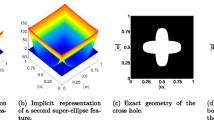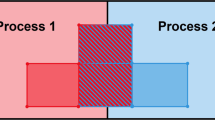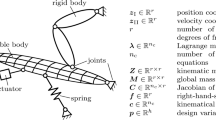Abstract
Mechanical systems subject to vibration are prevalent across many industries. Although potentially different in application, they sometimes share the need to minimize aspects of flexural deformation given harmonic loading and the need to consider a variety of both input and response-based constraints in the process. Practical design efforts also sometimes include the need for consideration of the optimal response of a platform-style product, including responses of multiple design variants supported by a common base structure. Harmonic problems can be especially challenging to optimize due to the likelihood that the response will be multi-modal; influenced by system natural frequencies throughout the design space. Further, analysis of these systems often involves large and complex computer models which require significant resources to execute. A harmonically loaded, platform-style parallel beam system with multiple family variants is used as an example in this work to demonstrate a proposed method for identifying an optimum in a constrained, multi-modal response environment with consideration for Expensive Black Box Functions (EBBF). The presented method proposes a combined approach where the high modality, EBBF’s domain is first surveyed for potential areas of optimal response using a method of Steepest Feasible Descent (SFD), followed by a local search in the optimal region using a more efficient direct search method. The method of SFD is a modification of the classical method of Steepest Descent, made useful for constrained models by a penalty system including both deterministic and programmatic methods. A sensitivity-based search vector method also helps to manage situations where significant difference in magnitude exists among the design variables. Evidentiary support for these key program elements is provided using standardized test functions. The effectiveness of the method is demonstrated by seeking a minimum flexural response for a parallel beam system subject to elastic support and response constraints.








Similar content being viewed by others
References
Akesson B, Olhoff N (1988) Minimum stiffness of optimally located supports for maximum value of beam eigenfrequencies. J Sound Vib 120(3):457–463
Banks A, Vincent J, Anyakoha C (2007) A review of particle swarm optimization. Part I: background and development, Natural Computing 6(4):467–484
Cai X, Qiu H, Gao L, Yang P, Shao X (2017) A multi-point sampling method based on kriging for global optimization. Struct Multidiscip Optim 56(1):1–18
Chen T, Chi T (2010) On the improvements of the particle swarm optimization algorithm. Adv Eng Softw 41(2):229–239
Den Hartog JP (1985) Mechanical vibrations. Courier Corporation
Fliege J, Svaiter B (2000) Steepest descent methods for multicriteria optimization. Math Meth Oper Res 51(3):479–494
Hajela P (1990) Genetic Search – An Approach to the Nonconvex Optimization Problem. AIAA J 28(7):1205–1210
Hall MC, Cacuci DG, Schlesinger ME (1982) Sensitivity analysis of a radiative-convective model by the adjoint method. J Atmos Sci 39(9):2038–2050
Hao K, Mei L, Ripin Z (2011) Tuned vibration absorber for suppression of hand-arm vibration in electric grass trimmer. Volucella 41:494–508
Jones D, Schonlau M, Welch W (1998) Efficient global optimization of expensive black-box functions. J Glob Optim 13(4):455–492
Kolda T, Lewis R, Torczon V (2003) Optimization by direct search: New perspectives on some classical and modern methods. Society for Industrial and Applied Mathematics 45(3):385–482
Laskari E, Parsopoulos K, Vrahatis M (2004) Particle swarm optimization for minimax problems. Evolutionary Computing CEC 2:1980–1987
Lophaven S, Nielsen H, Sondergaard J (2002) Amatlab Kriging Toolbox. Technical University of Denmark, Kongens Lyngby, Technical Report No. IMM-TR-2002-12
Martins JR, Alonso JJ, Reuther JJ (2005) A coupled-adjoint sensitivity analysis method for high-fidelity aero-structural design. Optim Eng 6(1):33–62
Maute K, Nikbay M, Farhat C (2003) Sensitivity analysis and design optimization of three-dimensional non-linear aeroelastic systems by the adjoint method. Int J Numer Methods Eng 56(6):911–933
Molga M, Smutnicki C (2005) Test Functions for Optimization Needs
Othmer C (2014) Adjoint methods for car aerodynamics. J Math Ind 4(1):6
Ozguven H, Candir B (1986) Suppressing the first and second resonances of beams by dynamic vibration absorbers. J Sound Vib 111(3):377–390
Pierson H (2012) Tunable dynamic support for resonance avoidance in bar feeders, Dissertation presented in partial fulfillment of the requirements for the degree of Doctor of Philosophy in the Graduate School of the Ohio State University, Industrial and Systems Engineering
Russell D (2006) Bending modes, Damping and the sensation of sting in baseball bats, Engineering of Sport 6, 6th International Sports Engineering Conference, ISEA
Shahbazi K (2005) An explicit expression for the penalty parameter of the interior penalty method. J Comput Phys 205(2):401–407
Shan S, Wang G (2010) Survey of modeling and optimization strategies to solve high-dimensional design problems with computationally-expensive black-box functions. Struct Multidiscip Optim 41(2):219–241
Tabatabaei M, Hakanen J, Hartikainen M, Miettinen K, Sindhya K (2015) A survey on handling computationally expensive multiobjective optimization problems using surrogates: non-nature inspired methods. Struct Multidiscip Optim 52(1):1–25
Vanderplaats GN (2007) Multidiscipline design optimization, 1st edn. Vanderplaats Research and Development, Incorporated. Colorado Springs
Venter G, Sobieszczanski-Sobieski J (2003) Particle Swarm Optimization. AIAA J 41(8):1583–1589
Vesterstrøm J, Thomsen R (2004) A comparative study of differential evolution, particle swarm optimization, and evolutionary algorithms on numerical benchmark problems, Evolutionary Computation, CEC2004. Volucella 2:1980–1987
Wang B, Chen J (1996) Application of genetic algorithm for the support location optimization of beams. Comput Struct 58(4):797–800
Wang D (2004) Optimization of support positions to minimize the maximal deflection of structures. Int J Solids Struct 41(26):7445–7458
Wang D, Jiang J, Zhang W (2004) Optimization of support positions to maximize the fundamental frequency of structures. Int J Numer Methods Eng 61(10):1584–1602
Wang D (2006) Optimal design of structural support positions for minimizing maximal bending moment. Finite Elem Anal Des 43(2):95–102
Wang D, Friswell M, Lei Y (2006) Maximizing the natural frequency of a beam with an intermediate elastic support. J Sound Vib 291(3–5):1229–1238
Yang C, Li D, Cheng L (2011) Dynamic vibration absorbers for vibration control within a frequency band. J Sound Vib 330(8):1582–1598
Zhu J, Zhang W (2006) Maximization of structural natural frequency with optimal support layout. Struct Multidiscip Optim 31(6):462–469
Zoutendijk G (1960) Methods of feasible directions. Elsevier, Amsterdam
Author information
Authors and Affiliations
Corresponding author
Ethics declarations
Conflict of Interest
The authors declare that they have no conflict of interest.
Rights and permissions
About this article
Cite this article
Hauser, B.R., Wang, B.P. Optimal design of a parallel beam system with elastic supports to minimize flexural response to harmonic loading using a combined optimization algorithm. Struct Multidisc Optim 58, 1453–1465 (2018). https://doi.org/10.1007/s00158-018-1973-8
Received:
Revised:
Accepted:
Published:
Issue Date:
DOI: https://doi.org/10.1007/s00158-018-1973-8




